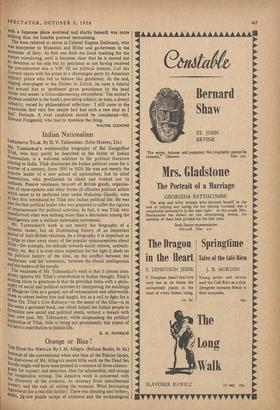Orange or Blue ?
THE DEAD SEA SCROLLS. By J. M. Allegro. (Pelican Books, 3s. 6d.) INSTEAD of the conventional white and blue of the Pelican books, the dust-cover of Mr. Allegro's recent little work on the Dead Sea Scrolls might well have been printed in a mixture of three colours: green for mystery and detection, blue for scholarship, and orange imaginative writing. The detective work is concerned with the discovery of the evidence, its recovery from unauthorised 0. wners, and the task of editing the material. What fascinating Ingredients for a real-life thriller ! There was shooting and bribery, codes, jig-saw puzzle scraps of evidence and the archeological
equivalent of 'forensic science': there were Eastern ecclesiastics playing for high stakes over documents that might unsettle the faith of millions, with even a hint of fabulous buried treasure at the end. Mr. Allegro was a member of the team working in Jerusalem on the finds, and he was in a good position to piece together the tale. This aspect of the book is magnificently told.
The author, however, is by profession not a sleuth but a scholar, and his book contains some interesting material for the expert. Some of his sources are as yet unpublished, and he has included a valuable bibliography on Qumran. Here and there I would query a point, but within its necessary limits his account of the Qumran community by the Dead Sea is accurate and judicious.
In the later chapters Mr. Allegro makes tentative comparisons between some of the beliefs of Qumran and those of the early Church. I feel that this part of his book qualifies for the orange cover because the most important of his suggestions seem to lack sufficient evidence to support them. Thus Mr. Allegro asserts that 'there was nothing formally incompatible in the Messianic expectations of the Qumran community and the Christian Messiah,' but unfortunately he fails to discuss any of the grave objections to such a view. He would also see the advanced Christology of Paul as far removed from a primitive conception of Jesus as the Messiah of David, yet in this connection he does not mention the even more advanced Christology of the Fourth Gospel, whose material he claims from the Qumran evidence must now be recognised as founded in the earliest layers of Gospel traditions.
Such matters involve large and important questions, but although they form the climax of his book, Mr. Allegro's treat- ment of them is cursory and elusive. His real viewpoint on the relation of Qumran to Christianity is hard to assess because It is difficult to discover.
FIUGH MONTEPIORR



















































 Previous page
Previous page